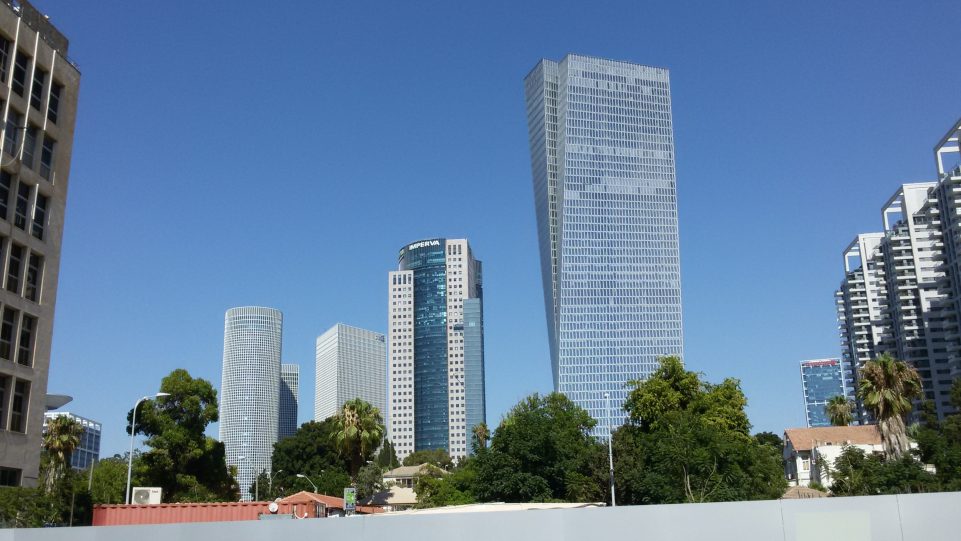Dateline Tel Aviv — No wonder Tel Aviv is ranked as the ultimate vacation destination. Known as the city that never sleeps, it often is compared to Las Vegas – 24-hour entertainment, clubs, bars, restaurants, all-night partying.
It also is a city of museums, the world- renowned Israel Philharmonic Orchestra, an opera house, live theatre, and various cultural activities.
Tel Aviv offers the pristine white sandy beaches stretching for miles along the shores of the Mediterranean Sea.
Glistening waters of turquoise, aqua and deeper shades of blue converge from three directions, meeting at the apex of wet sand. The waters are calm and clear, complementing the cloudless blue sky.
Tel Aviv is known for its unusual architecture.
Each modern building is unique in form and material. Old and new blend beautifully. Known as the White City for its German modernist Bauhaus style of architecture of the 1920s, UNESCO made the White City of Tel Aviv a World Heritage Site. It has the most Bauhaus buildings in the world.
Building on History
Bauhaus is characterized by white walls, rounded corners, balconies, flat roofs, pillars, and thermometer windows.
But Tel Aviv architecture is more than Bauhaus.
One high-rise appears to be leaning like the Tower of Pisa, a skyscraper built purposely on a slant.
My taxi driver said the architect must have been drunk.
Another building reminds me of an upside down pyramid, but it is all an illusion.
Some buildings have giant concrete champagne glass structures sitting atop their roofs. Some look like flying saucers, but they are actually helicopter pads on the tops of buildings.
Architecturally all they have in common are the steel, and blue- or green-tinted glass walls.
Yet at the entrance to the Carmel Shuk, buildings have a distinctive French flavor with colorful wooden shutters flanking the windows and matching painted wrought iron enclosed balconies, reminding me of New Orleans.
Close to the train station are the Azrieli Towers, three adjacent geometric high- rise glass buildings, one shaped like a circle, one like a square, one like a triangle.
They are connected by a four-story shopping mall at its base. Inside are life-size bronze statues of people sitting on a bench, another leaning up against a wall reading a newspaper, and various other life-like bronze sculptures throughout the mall.
In the center of the city is the newly renovated Sarona Market complex surrounded by high-rises.
Sarona, an area of restored German Templar buildings dating to the late 1800s, houses boutiques, designer shops, art galleries, cafes, restaurants and bars scattered amid gardens and flowers.
The indoor Sarona Market features bakeries, restaurants, stalls and stands of fruits, vegetables, spices, meats, fish, wines, cheese and desserts galore!
Older low rise buildings line the avenues and boulevards of Tel Aviv, outdoor cafes where people leisurely congregate, reading newspapers, chatting with friends under giant wide colorful patio umbrellas.
All of this while awaiting gastronomic delights from the kiosks, cafes and restaurants. Definitely a European flair.
My favorite site, and sight, amid the modern buildings is a complex of older one-story bungalows built in the 1940s.
The windows have shutters and heavy looking doors. That is the impression from across the street. Up close, the windows and doors actually are expertly painted pictures nailed onto slats of wood along the sides of the windowless exteriors of the bungalows.
The fake facades are like the make-believe buildings seen on a tour of a Universal Studios’ movie backlot.
However, these windowless buildings used to house government offices years ago. The windowless walls were for blackout purposes and for concealing the secret work going on inside.
Bicycles Are the Answer
Almost half of Israel’s population lives in metropolitan Tel Aviv and its surrounding cities and towns. Therefore, it is like most major cities, a traffic nightmare. So to fight traffic, limited parking, and air pollution, Israelis ride bicycles. For example, there is a bike path linking the two cities of Tel Aviv and Herzliya. In Tel Aviv, bikes are rented from 80 docking stations with bicycles positioned throughout the city.
Two thousand bikes are rented every day. A person picks up a bike in one part of the city and drops it off on the other side of town. That enables him/her to do whatever he/she wants to do after dropping off the bike.
Another person picks up that same bike and rides to his/her destination. Both riders pick up a new bike when they need one. Special trucks go around the city to balance the inventory of bicycles from full stations to empty stations so that bike rentals are available for everyone.
Tel Aviv literally means “Spring Mound” or hill.
A tel is an archaeological site that reveals layers of civilizations built over each other.
Essentially it is an artificial mound or hill formed and built on the ancient remains of people living on the same site for thousands of years.
When a city begins to fall down, its inhabitants knock down its walls and build on top of the rubble. Aviv means spring.
The city of Tel Aviv was named because it represented the rebirth or spring of the Jewish nation in a place where it previously was.
A great place to visit. But very expensive to live there.
L’hitraot. Shachar

